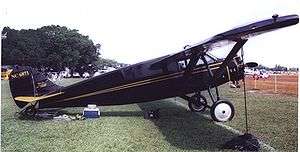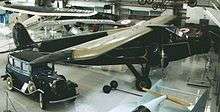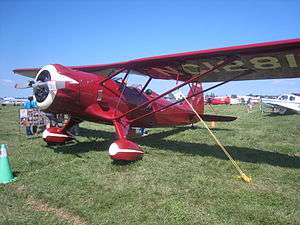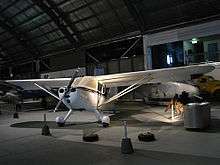Stinson Aircraft Company
| Corporation | |
| Industry | General Aviation |
| Founded | 1920 |
| Headquarters | Dayton, Ohio |
Key people | Eddie Stinson, founder |



The Stinson Aircraft Company was an aircraft manufacturing company in the United States between the 1920s and the 1950s.
The Company
The Stinson Aircraft Company was founded in Dayton, Ohio, in 1920 by aviator Edward “Eddie” Stinson, the brother of Katherine Stinson. After five years of business ventures, Stinson made Detroit, Michigan the focus of his future flying endeavors. Stinson found Detroit's business community receptive to his plans. A group of local businessmen — the Detroit Board of Commerce's Aviation Committee — supported Stinson's plans to establish the Stinson Aircraft Syndicate in 1925 at a site southwest of Detroit, where today's Detroit Metropolitan Wayne County Airport is located, and provided $25,000 to develop a new monoplane; the SM-1 Detroiter made its first flight on January 25, 1926, and became an overnight success that enabled Stinson to quickly assemble $150,000 in public capital to incorporate the Stinson Aircraft Corporation on May 4, 1926. Always an aviator at heart, Eddie Stinson was still flying as a stunt pilot, earning $100,000 a year for his efforts — a huge sum in those days. Stinson Aircraft Corporation sold 10 SM-1 Detroiters in 1926. Business was steadily increasing, and Stinson delivered 121 aircraft in 1929.
Automobile mogul Errett Lobban (E.L.) Cord acquired 60 percent of Stinson's stock in September 1929, and his Cord Corporation provided additional investment capital to permit Stinson to sell its aircraft at a competitive price while still pursuing new designs. At the height of the Depression in 1930, Stinson offered six aircraft models, ranging from the four-seat Junior to the Stinson 6000 trimotor airliner.
Eddie Stinson did not live to enjoy the success of his company. He died in an air crash in Chicago, Illinois on January 26, 1932, while on a sales trip. At the time of his death at age 38, Stinson had acquired more than 16,000 hours of flight time — more than any other pilot at the time.
The Stinson name did not last much past the end of World War II. Eddie Stinson's death accelerated the assimilation of Stinson Aircraft Corporation into larger corporate entities: first by Cord Corporation, then by Aviation Corporation (AVCO), and later by Consolidated Vultee.[1] By 1950 the Stinson company was sold to the Piper Aircraft Corporation, which continued to produce 108s for a limited time. Piper transformed an original Stinson design (the "Twin Stinson") into the successful Piper Apache, the world's first general aviation all-metal twin-engined modern aircraft.
Aircraft
Stinson SB-1 Detroiter
The four-seat biplane Stinson SB-1 Detroiter made its first flight on January 25, 1926 — possibly the first fixed-wing aircraft with a heated, soundproof cabin, electric starter, and wheel brakes. Powered by either a Wright J-5 (SB-1) or Wright J-6 (SB-1D), the Detroiter became an overnight success with a number of airlines including Florida Airways, Wien Alaska Airways and Northwest Airways. Two were sponsored by Detroit News on an unsuccessful attempt by Wilkins to fly across the north pole, though he succeeded the following year. [2]
Stinson SM-1 Detroiter
The six-seat monoplane Stinson SM-1 Detroiter was selected by Ruth Elder and Elsie Mackay for their attempted trans-Atlantic crossings in 1927 and 1928, both of which failed.[2]
A cooperation with the Packard Motor Car Co. of Detroit culminated in the first Diesel engined aircraft, the Stinson Detroiter SM1B-X7654. Work took place at the Packard Proving Grounds at Utica, Michigan; the plane flew successfully in the evening of September 18, 1928, with Packard test-pilot, Walter Lees and designer Captain Lionel M. Woolson. Charles Lindbergh tested the Diesel-powered aircraft during a visit in Utica on August 15, 1929.[3]
Stinson SM-2 Junior
Soon after the SM-1 Detroiter hit the market, Stinson started refining the basic design in 1928 to appeal to private flyers and business owners. The SM-2 Junior, was a smaller and lower-powered three-four seat high-wing cabin monoplane of which 321 were built by 1933.
Depression-era aircraft

At the height of the Depression in 1930, Stinson offered six aircraft models, ranging from the four-seat Junior to the high-wing Stinson SM-6000 trimotor Airliner.
Two new Stinson designs — the 1931 Model W and the 1932 Model R-2/3 — were powered by Wright or Lycoming radial engines and combined dependable performance with a luxurious cabin. These two models were the ancestors of the most famous of the Stinson line — the Reliant, first introduced in 1933.
In 1933 Stinson introduced its last trimotor airliner, the low-wing Stinson Model A.
In 1933 and 1934, The Stinson Model "O", a high-wing parasol aircraft was delivered for a military trainer. Ten were produced, five of which were sold to Honduras, three to China, and one to Brazil. The prototype remained in the U.S. as an instrument trainer in Long Beach, California.[4] It was removed from the registry in 1945. None of the other 9 aircraft are in existence today.
The Model O was the only open-cockpit aircraft built by Stinson. It is flown from the front with a gunner or second pilot/student in the rear.
Stinson SR Reliant
From 1933 to 1941, Stinson delivered 1,327 Reliants—ranging from the SR-1 through the SR-10 — each variation building upon its predecessor with upgraded engines and design refinements. The Stinson Reliant SR-10, introduced in 1938, was the penultimate commercial variant, featuring leather upholstery, walnut instrument panels, and automobile-style roll-down windows.
Stinson L-1 Vigilant
The Stinson L-1 Vigilant was a light liaison, observation aircraft built for the US Army Air Corps.
Model 105 Voyager/L-5 Sentinel
Another popular Stinson aircraft was the Model 105 Voyager, also called the HW-75 and Model 10, a three-passenger aircraft featuring a strut-braced wing mounted on the top of the fuselage and capable of flying at about 105 miles per hour (169 km/h). The little HW-75 proved an immediate success attracting a flood of orders the manufacturer was hard-pressed to match. Costing $US2,995 in 1939, the Voyager featured innovations such as slotted wing flaps, and fixed wing slots for better handling at lower speeds.
By August 1939 Stinson had received more than 100 orders and the company’s plant at Wayne, Michigan was rolling out three aircraft each day. James Stewart, air-minded Hollywood movie star, and Howard Hughes were some of the more notable Voyager owners.
Introduced in 1939, Stinson sold 535 Voyagers in 1939 and 1940 before World War II intervened and the Stinson aircraft line was adapted for an important mission. A few prewar Voyagers were commandeered for wartime use and designated the AT-19/L-9 (not the same as the later AT-19 which was a Stinson Reliant).

The 105 Voyager was substantially redesigned to become the U.S. Army's L-5 Sentinel, one of the most used and least recognized U.S. aircraft of the Second World War. Serving as a short field liaison aircraft, the L-5 supported missions such as artillery spotting, medical evacuation, aerial reconnaissance, and passenger transport. Stinson delivered 3,590 between November 1942 and September 1945 under a variety of designations from L-5, L-5B, L-5C, L-5E and L-5G.
The U.S. Navy and Marine Corps received 306 Sentinels from the Army, designating their models as the OY-1 and OY-2, while two versions went to the Royal Air Force as the Sentinel Mk. I and Sentinel Mk. II. After the war, most Sentinels were sold as surplus, but a number of aircraft (now designated the U-19) served in the Korean War. A few remained in active military service until the late 1950s.
AT-19/V-77 Reliant
The SR-10 Reliant was also impressed for use in World War II as the UC-81, used by the U.S. Army as a utility aircraft. Purpose-built examples following a major redesign to military specifications were designated AT-19/V-77, and used by the U.S. Army and Royal Navy as light passenger transport, instrument trainer and photo-reconnaissance aircraft.
Stinson L-13
The Stinson L-13 was a observation and utility aircraft, 302 were built for the post-war US Air Force and Army.
Stinson 108
The last Stinson aircraft design produced was the Stinson 108, an immediate post-World War II design that competed against designs from Piper Aircraft and Cessna.
References
- ↑ Flying Magazine: 78. August 1945. Missing or empty
|title=(help) - 1 2 "Stinson SB-1" (PDF). Retrieved 2011-08-22.
- ↑ "Stinson SM-1 Packard". Retrieved 2012-06-25.
- ↑ http://www.airventure.org/news/2010/100415_stinson.html
- "Stinson Aircraft Corporation" by Roger Guillemette, US Centennial of Flight Commission, retrieved January 6, 2006
External links
- Stinson "S" Junior Specifications and Photos
- Short story and pictures of the Packard Diesel-powered Stinson SM-1